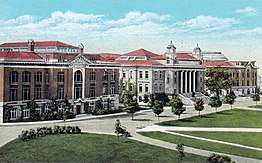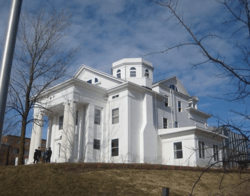Syracuse University
Syracuse University (Syracuse, 'Cuse, or SU[8]) is a private research university in Syracuse, New York. The institution's roots can be traced to the Genesee Wesleyan Seminary, founded in 1831 by the Methodist Episcopal Church in Lima, New York. After several years of debate over relocating the college to Syracuse, the university was established in 1870, independent of the college. Since 1920, the university has identified itself as nonsectarian,[9][10][11][12] although it maintains a relationship with The United Methodist Church.[13][14][15][16][17]
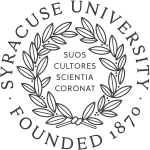 | |
| Motto | Suos Cultores Scientia Coronat (Latin) |
|---|---|
Motto in English | Knowledge crowns those who seek her |
| Type | Private research university |
| Established | March 24, 1870[1] |
Academic affiliations | |
| Endowment | $1.39 billion (2019)[2] |
| Budget | $1.5 billion (2019)[3] |
| Chancellor | Kent Syverud |
| Provost | John Liu (Interim) |
Academic staff | 1,563[4] |
| Students | 22,850 (2019)[5] |
| Undergraduates | 15,275 (2019)[5] |
| Postgraduates | 7,575 (2019)[5] |
| Location | , New York , United States 43.0376°N 76.1340°W |
| Campus | Urban, 683 acres (276.4 ha)[6] |
| Colors | Orange[7] |
| Nickname | Orange |
Sporting affiliations | NCAA Division I ACC, CHA, EARC, MAISA |
| Mascot | Otto the Orange |
| Website | www |
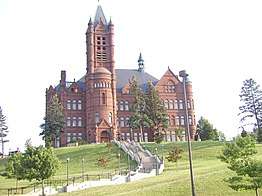
The campus is in the University Hill neighborhood of Syracuse, east and southeast of downtown, on one of the larger hills. Its large campus features an eclectic mix of buildings, ranging from nineteenth-century Romanesque Revival structures to contemporary buildings. SU is organized into 13 schools and colleges, with nationally recognized programs in information studies and library science, architecture, communications, business administration, inclusive education and wellness, sport management, public administration, engineering and the College of Arts and Sciences.
Syracuse University athletic teams, known as the Orange, participate in 20 intercollegiate sports. SU is a member of the Atlantic Coast Conference, or ACC for all NCAA Division I athletics,[18] except for the men's rowing and women's ice hockey teams.[19][20] SU is also a member of the Eastern College Athletic Conference.[21]
History
Founding
The Genesee Wesleyan Seminary was founded in 1831 by the Genesee Annual Conference of the Methodist Episcopal Church in Lima, New York, south of Rochester.[22] In 1850, it was resolved to enlarge the institution from a seminary into a college, or to connect a college with the seminary, becoming Genesee College. However, the location was soon thought by many to be insufficiently central. Its difficulties were compounded by the next set of technological changes: the railroad that displaced the Erie Canal as the region's economic engine bypassed Lima completely. The trustees of the struggling college then decided to seek a locale whose economic and transportation advantages could provide a better base of support.
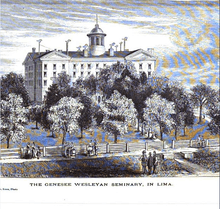

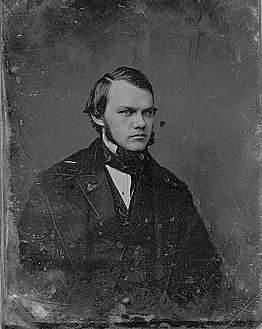
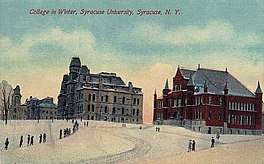
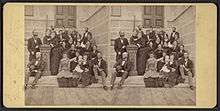
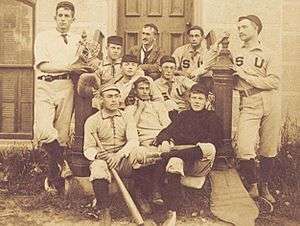
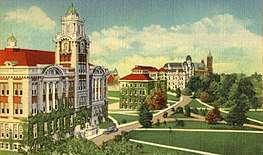
The college began looking for a new home at the same time Syracuse, ninety miles to the east, was engaged in a search to bring a university to the city, having failed to convince Ezra Cornell and Andrew Dickson White to locate Cornell University there rather than in Ithaca.[28][29] Syracuse resident White pressed that the new university should locate on the hill in Syracuse (the current location of Syracuse University) due to the city's attractive transportation hub, which would ease the recruitment of faculty, students, and other persons of note. However, as a young carpenter working in Syracuse, Cornell had been twice robbed of his wages,[30][31] and thereafter considered Syracuse a Sodom and Gomorrah, insisting the university be in Ithaca on his large farm on East Hill, overlooking the town and Cayuga Lake.
Meanwhile, there were several years of dispute between the Methodist ministers, Lima, and contending cities across the state, over proposals to move Genesee College to Syracuse. At the time, the ministers wanted a share of the funds from the Morrill Land Grant Act for Genesee College. They agreed to a quid pro quo donation of $25,000 from Senator Cornell in exchange for their (Methodist) support for his bill. Cornell insisted the bargain be written into the bill and Cornell became New York State's Land Grant University in 1865. In 1869, Genesee College obtained New York State approval to move to Syracuse, but Lima got a court injunction to block the move, and Genesee stayed in Lima until it was dissolved in 1875.[32] By that time, however, the court injunction had been made moot by the founding of a new university on March 24, 1870. On that date the State of New York granted the new Syracuse University its own charter, independent of Genesee College.[32] The City of Syracuse had offered $100,000 to establish the school.[32] Bishop Jesse Truesdell Peck had donated $25,000 to the proposed school[33] and was elected the first president of the Board of Trustees.[29]
Rev. Daniel Steele, a former Genesee College president, served as the first administrative leader of Syracuse until its chancellor was appointed.[34] The university opened in September 1871 in rented space downtown.[32] George F. Comstock, a member of the new university's board of trustees, had offered the school 50 acres (200,000 m2) of farmland on a hillside to the southeast of the city center. Comstock intended Syracuse University and the hill to develop as an integrated whole; a contemporary account described the latter as "a beautiful town ... springing up on the hillside and a community of refined and cultivated membership ... established near the spot which will soon be the center of a great and beneficent educational institution."[35]
The university was founded as coeducational. President Peck stated at the opening ceremonies, "The conditions of admission shall be equal to all persons... there shall be no invidious discrimination here against woman.... brains and heart shall have a fair chance... "[36] Syracuse implemented this policy with a high proportion of women students. In the College of Liberal Arts, the ratio between male and female students during the 19th century was approximately even. The College of Fine Arts was predominantly female, and a low ratio of women enrolled in the College of Medicine and the College of Law.[36] Men and women were taught together in the same courses, and many extra-curricular activities were coeducational as well. Syracuse also developed "women-only" organizations and clubs.[36]
Expansion
Coeducation at Syracuse traced its roots to the early days of Genesee College where educators and students like Frances Willard and Belva Lockwood were heavily influenced by the Women's movement in nearby Seneca Falls, NY. However, the progressive "co-ed" policies practiced at Genesee would soon find controversy at the new university in Syracuse.[29] Colleges and universities admitted few women students in the 1870s. Administrators and faculty argued women had inferior minds and could not master mathematics and the classics. Dr. Erastus Otis Haven, Syracuse University chancellor and former president of the University of Michigan and Northwestern University, maintained that women should receive the advantages of higher education. He enrolled his daughter, Frances, at Syracuse where she joined the other newly admitted female students in founding the Gamma Phi Beta sorority.[29] The inclusion of women in the early days of the university led to the proliferation of various women's clubs and societies. In fact, it was a Syracuse professor who coined the term "sorority" specifically for Gamma Phi Beta.[37]
In the late 1880s the university engaged in a rapid building spree. Holden Observatory (1887)[38] was followed by two Romanesque Revival buildings – von Ranke Library (1889), now Tolley Humanities Building,[39] and Crouse College (1889).[40] Together with the Hall of Languages, these first buildings formed the basis for the "Old Row," a grouping which, along with its companion Lawn, established one of Syracuse's most enduring images.[35] The emphatically linear organization of these buildings along the brow of the hill follows a tradition of American campus planning which dates to the construction of the "Yale Row" in the 1790s. At Syracuse, "The Old Row" continued to provide the framework for growth well into the twentieth century.[35]
From its founding until through early 1920s, the university grew rapidly. It offered programs in the physical sciences and modern languages, and in 1873, Syracuse added one of the first architecture programs in the U.S.[41] In 1874, Syracuse created the nation's first bachelor of fine arts degree,[42] and in 1876, the school offered its first post-graduate courses in the College of Arts and Sciences.[41] SU created its first doctoral program in 1911.[43] In 1919, Syracuse added its business school which contains multiple MBA programs.[44] SU's school of journalism, now the S.I. Newhouse School of Public Communications, was established at Syracuse in 1934.[45]
The growth of Syracuse University from a small liberal arts college into a major comprehensive university were due to the efforts of two men, Chancellor James Day and John D. Archbold. James Roscoe Day was serving the Calvary Church in New York City where he befriended Archbold. Together, the two dynamic figures would oversee the first of two great periods of campus renewal in Syracuse's history.[29]
John Dustin Archbold was a capitalist, philanthropist, and President of the Board of Trustees at Syracuse University. He was known as John D. Rockefeller's right-hand man and successor at the Standard Oil Company. He was a close friend of Syracuse University Chancellor James R. Day, and gave almost $6 million to the university over his lifetime.[29] Said a journalist in 1917:
Mr. Archbold's ... is the president of the board of trustees of Syracuse University, an institution which has prospered so remarkably since his connection with it that its student roll has increased from hundreds to over 4,000, including 1,500 young women, placing it in the ranks of the foremost institutions of learning in the United States.[46]
In 1905 Rev. Dr. James D. Phelps secured a donation of $150,000 from Andrew Carnegie for a new university library provided the University raised an equal sum as an endowment for the library. The University raised the required endowment in little over a month with the largest share being contributed by John D. Archbold. On September 11, 1907 the transfer of the Von Ranke collection from the old library building marking the opening of the new Carnegie library with a collection of over 71,000 volumes.[26]
In addition to keeping the university financially solvent during its early years, John D. Archbold also contributed funds for eight buildings, including the full cost of Archbold Stadium (opened 1907, demolished 1978), Sims Hall[47] (men's dormitory, 1907), the Archbold Gymnasium (1909, nearly destroyed by fire in 1947, but still in use), and the oval athletic field.
Modern
After World War II, Syracuse University began to transform into a major research institution. Enrollment increased in the four years after the war due to the G.I. Bill, which paid tuition, room, board, and a small allowance for veterans returning from World War II. In 1946, SU admitted 9,464 freshmen, nearly four times greater than the previous incoming class.[45] Branch campuses were established in Endicott, New York, and Utica, New York, which became Binghamton University and Utica College respectively.
The velocity with which the university sped through its change into a major research institution was astounding. By the end of the 1950s, Syracuse ranked twelfth nationally in terms of the amount of its sponsored research, and it had over four hundred professors and graduate students engaging in that investigation.[41]
From the early 1950s through the 1960s, Syracuse University added programs and staff that continued the transformation of the school into a research university. In 1954, Arthur Phillips was recruited from MIT and started the first pathogen-free animal research laboratory. The lab focused on studying medical problems using animal models. The School of Social Work, which eventually merged into the College of Human Ecology, was founded in 1956.[48] Syracuse's College of Engineering also founded the nation's second oldest computer engineering and bioengineering programs. In 1962, Samuel Irving Newhouse Sr. donated $15 million to begin construction of a school of communications, eventually known as the SI Newhouse School of Public Communications. In 1966, Syracuse University was admitted to the Association of American Universities, an organization of leading research universities devoted to maintaining a strong system of academic research and education.[49]
| Schools and colleges of Syracuse University (date of founding) | |||||||||||
|---|---|---|---|---|---|---|---|---|---|---|---|
| Undergraduate | College of Arts and Sciences 1870 |
University College 1918 |
College of Visual and Performing Arts 1873 |
School of Architecture 1873 |
School of Information Studies 1896 |
College of Engineering and Computer Science 1901 |
School of Education 1906 |
Falk College of Sport and Human Dynamic 1918 |
Martin J. Whitman School of Management 1919 |
S. I. Newhouse School of Public Communications 1964 | |
| Graduate | College of Law 1895 |
Graduate School 1912 |
Maxwell School of Citizenship and Public Affairs 1924 | ||||||||
1988 crash of Pan Am Flight 103
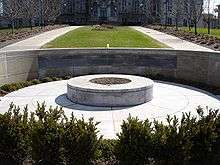
On December 21, 1988, 35 Syracuse University students were killed in the terrorist bombing of Pan Am Flight 103 over Lockerbie, Scotland. The students were returning from a study-abroad program in Europe. That evening, Syracuse University went on with a basketball game just hours after the attack, for which the university was severely criticized and the university's chancellor subsequently apologized.[50][51] The bombing of Flight 103 was the deadliest terrorist attack against the United States prior to the attacks on September 11, 2001.[52][53]
In April 1990, Syracuse University dedicated a memorial wall to the students killed on Flight 103, constructed at the entrance to the main campus in front of the Hall of Languages. Every year the university holds "Remembrance Week" during the fall semester to commemorate the students. The university also maintains a link to the tragedy with the "Remembrance Scholars" program, when 35 senior students receive scholarships during their final year at the university. With the "Lockerbie Scholars" program, two graduating students from Lockerbie Academy study at Syracuse for one year.[54]
Controversies
In 2018, the university's Theta Tau fraternity was expelled after a video showing an initiation ritual featuring racist, anti-Semitic, ableist, and homophobic language.[55][56]
In 2019, over ten instances of racist graffiti, swastikas, and other bigoted language were found around campus.[57] That same week, the Alpha Chi Rho fraternity was suspended after the university determined that four of its members yelled a racial epithet at a black student on campus.[58] Days later, a white supremacist manifesto was allegedly sent to several students studying in the library using Apple's AirDrop service and was also posted on a website about Greek Life at Syracuse University—the same manifesto that had been cited prior to the Christchurch mosque shootings.[59][60] The Syracuse Police Department or the university's Department of Public Safety could not verify these claims and to date have not been able to find devices that received such a manifesto.[61][62] In response, Syracuse University denied that there was any "credible threat", and the chancellor in his address to the senate said that the alleged circulation of the manifesto "was probably a hoax".[63] However, Syracuse University and chancellor Kent Syverud have faced criticism for their handling of the situation.[59]
Facilitated communication controversy
As of 2018, the university had supported the discredited pseudoscientific practice of facilitated communication for nearly 30 years. The university's Institute on Communication and Inclusion (formerly called, the "Facilitated Communication Institute"), has offered workshops with the intent of "giving a voice and a means to communicate to people with disabilities".[64] However, in a 2016 article, the editorial board of the university newspaper The Daily Orange, condemned the university's support for this practice. "It is inexcusable and equal-parts embarrassing for Syracuse University as a research institution to stand behind facilitated communication (FC) despite it being a potentially life-destroying practice that has been empirically debunked."[65]
Campus
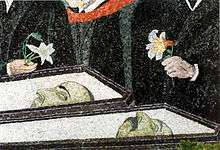
The university is set on a campus that features an eclectic mix of buildings, ranging from nineteenth-century Romanesque Revival structures to contemporary buildings designed by renowned architects such as I.M. Pei. The center of campus, with its grass quadrangle, landscaped walkways, and outdoor sculptures, offers students the amenities of a traditional college experience. The university overlooks downtown Syracuse, a medium-sized city (140,600 residents in 2008).[67] The school also owns a Sheraton Hotel,[68] the Drumlins Country Club – a nearby, 36-hole golf course,[69] the Fisher Center and Joseph I. Lubin House in New York City,[70] the Paul Greenberg House in Washington, D.C.,[71] and the Minnowbrook Conference Center, a 28-acre (121,000 m2) retreat in the Adirondack mountains of Upstate New York.[72]
Main campus
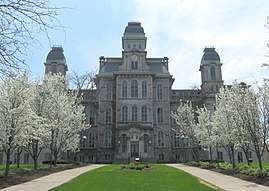

Also called "North Campus," the Main Campus contains nearly all academic buildings and residence halls. Its centerpiece is The Kenneth A. Shaw Quadrangle, more affectionately known as "The Quad",[73] which is surrounded by academic and administrative buildings, including Hendricks Chapel.[74] The North Campus represents a large portion of the University Hill neighborhood. Buses run to South Campus, as well as downtown Syracuse and other locations in the city.[75] About 70 percent of students live in university housing. First- and second-year students are required to live on campus. All 22 residence halls are coeducational and each contain a lounge, laundry facility, and various social/study spaces. Residence halls are secured with a card access system. Residence halls are located on both Main Campus and South Campus, the latter of which is a five-minute ride via bus. Learning communities and interest housing options are also available. Food facilities include six residential dining centers, two food courts, and several cafes.
The Comstock Tract Buildings, a historic district of older buildings on the campus, was listed on the National Register of Historic Places in 1980.[76] Three buildings on campus—the Crouse Memorial College and the Hall of Languages, and the Pi Chapter House of Psi Upsilon Fraternity—are individually listed on the National Register.[77]
A few blocks walk from Main Campus on East Genesee St, the Syracuse Stage building includes two proscenium theatres. The Storch is used primarily by the Drama Department and the Archbold is used primarily by Syracuse Stage, a professional regional theatre.
South campus
After World War II, a large, undeveloped hill owned by the university was used to house returning veterans in military-style campus housing. During the 1970s, this housing was replaced by permanent two-level townhouses for two or three students each, or for graduate family housing. There are also three small residence halls which feature open doubles. South Campus is also home to the Institute for Sensory Research, Tennity Ice Pavilion, Goldstein Student Center, Skytop Office Building and 621 Skytop Road (for administration), and the InnComplete Pub, a graduate student bar. Just north is the headquarters of SU Athletics, Manley Field House, located in the Manley Athletics Complex. Approximately 2,500 students live on the South Campus, which is connected to the main campus by frequent bus service.
Downtown
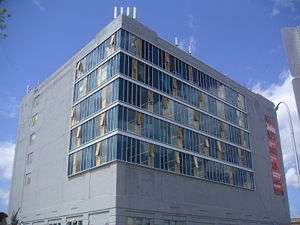
In December 2004, the university announced that it had purchased or leased twelve buildings in downtown Syracuse. Five design programs—Communication, Advertising, Environmental and Interior Design, Industrial and Interactive Design, and Fashion—reside permanently in the newly renovated facilities, fittingly called The Warehouse, which was renovated by Gluckman Mayner Architects. Both programs were chosen to be located in the downtown area because of their history of working on projects directly with the community. The Warehouse also houses a contemporary art space that commissions, exhibits, and promotes the work of local and international artists in a variety of media. Hundreds of students and faculty have also been affected by the temporary move of the School of Architecture downtown for the $12 million renovation of its campus facility, Slocum Hall.
Since 2009, the Syracuse Center of Excellence in Environmental and Energy Systems, led by Syracuse University in partnership with Clarkson University and the College Environmental Science and Forestry, creates innovations in environmental and energy technologies that improve human health and productivity, security, and sustainability in urban and built environments.[78][79] The Paul Robeson Performing Arts Company and the Community Folk Art Center will also be located downtown. On March 31, 2006, the university and the city announced an initiative to connect the main campus of the university with the arts and culture areas of downtown Syracuse and The Warehouse.[80] Using natural gas, the Green Data Center generates its own electricity on site, providing cooling for servers and for a neighboring building.[81]
The Connective Corridor project, supported by of public and private funds, will be a strip of cultural development that will connect the main campus of the university to downtown Syracuse, NY. In 2008, an engineering firm is studying traffic patterns and lighting to commence the project. A design competition was held to determine the best design for the project.[82]
Metropolitan satellite locations
SU has established an admissions presence in Los Angeles, California, that will enhance the university's visibility on the West Coast and will join the university's West Coast offices of alumni relations, institutional advancement, and the LA semester program in the same location. Syracuse University has also established an admissions presence in New York City, Atlanta, Georgia, Chicago, Illinois, and Boston, Massachusetts.[83] Maxwell School of Citizenship and Public Affairs maintains their Washington D.C. operations in collaboration with Center for Strategic and International Studies.[84][85]
Art on campus and permanent collections
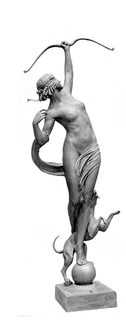
Syracuse is home to the Syracuse University Art Museum,[86] whose mission is to be a place of rigorous interdisciplinary research, creative thinking and mindfulness. The main gallery space is located in the Shaffer Art Building on the main campus.
The Warehouse Gallery[87] is a new contemporary art space exhibiting that is operated under the umbrella of the SU Art Museum. Housed in a former furniture warehouse off campus, the Warehouse Gallery features works from international artists in a variety of media. Its mission is to engage the community in a dialogue regarding the role the arts can play in illuminating the critical issues of our times.
Also on campus is the Louise and Bernard Palitz Gallery.[88] Located on the second floor of the Lubin House, the Palitz gallery has a rotation of exhibitions, including two annual public shows, local and regional artists, featured items from the university's art collection, and professional artists.
There are many other venues for student work at Syracuse University. In the Shaffer Art Building is the Lowe Art Gallery,[89] which features student work. Gallery spaces are also available for reservation on the fourth floor of the Bird Library.[90]
Within the Schine Student Center is home to three gallery spaces.[91] The Robert B Menschel Photography Gallery features work from professional photographers as well as students and local artists. On the third floor is the Panasci Lounge Art Hanging space for two dimensional spaces. This space can be reserved by students. The White Cube Gallery, also on the third floor is a student gallery that showcases work for the student body outside of the school of art and design.
Students can also research primary sources through the Special Collections Research Center (SCRC)[92] which is composed of rare books, manuscripts, works of architecture and design, and popular culture (cartoons, science fiction, and pulp literature), photography, the history of recorded sound, and more.
SU has a permanent art collection of over 45,000 objects from artists including Picasso, Rembrandt, Hopper, Tiffany and Wyeth. More than 100 important paintings, sculptures, and murals are displayed in public places around campus. Notable sculptures on campus include Sol LeWitt's Six Curved Walls, Anna Hyatt Huntington's Diana, Jean-Antoine Houdon's George Washington, Antoine Bourdelle's Herakles, James Earle Fraser's Lincoln, Malvina Hoffman's The Struggle of Elemental Man, and Ivan Meštrović's Moses, Job and Supplicant Persephone.
Organization
Syracuse is governed by a 70-member Board of Trustees, with 64 trustees elected by the board to four-year terms, and six elected by the alumni to four-year terms. Of the 64 Board elected Trustees, three must represent specified conferences of the United Methodist Church. In addition, the chancellor and the President of the Syracuse Alumni Association serve as ex officio voting Trustees. Two students and one faculty member serve as non-voting representatives to the Board of Trustees.[93] The Board of Trustees selects, and sets the salary of, the chancellor. The Syracuse University Bylaws also establish a University Senate with "general supervision over all educational matters concerning the University as a whole". The Senate consists of administrators, faculty, students and staff.[93]
Admissions
Syracuse's admissions process is "more selective" according to the Carnegie Classification.[94] For the Class of 2018, there were approximately 34,614 applicants for 3,350 seats in the Freshman class.[95][96] Average SAT score of admitted student was 1271.[97]
In 2018, 26% of the incoming students were students of color; 18% were first-generation college students; 21% were federal Pell grant eligible (an indicator for low-income students), and 75% received some financial aid. Students came from 48 states, along with Washington, D.C., Guam and Puerto Rico. Nearly 600 international undergraduate students from 59 countries were also admitted.[97][98][99]
In addition, Syracuse University had a total acceptance rate of 47%.[98]
Academics
Syracuse is a comprehensive, highly residential research university. The majority of enrollments are in the full-time, four-year undergraduate program balances arts & sciences and professions. There is a high graduate coexistence with the comprehensive graduate program and a very high level of research activity.[94] It is accredited by the Middle States Commission on Higher Education.[100]
The most popular majors at Syracuse University include: Communication, Journalism, and Related Programs; Social Sciences; Business, Management, Marketing, and Related Support Services; Visual and Performing Arts; and Engineering. The average freshman retention rate, an indicator of student satisfaction, is 91 percent.[98] The student-faculty ratio at Syracuse University is 15:1, and the school has 58.5 percent of its classes with fewer than 20 students.
Degrees
SU offers undergraduate degrees in over 200 majors in the 9 undergraduate schools and colleges.[101] Bachelor's degrees are offered through the Syracuse University School of Architecture, the College of Arts and Sciences, the School of Education, the David B. Falk College of Sport and Human Dynamics, the College of Engineering and Computer Science, the School of Information Studies, Martin J. Whitman School of Management, S.I. Newhouse School of Public Communications, and the College of Visual and Performing Arts. Also offered are Master's and doctoral degrees online[102] and in person from the Graduate School and from specialized programs in the Martin J. Whitman School of Management, Maxwell School of Citizenship and Public Affairs, College of Law, among others. Additionally, SU offers Certificates of Advanced Study Programs for specialized programs for education, counseling, and other academic areas.[103][104][105]
The university has offered multiple international study programs since 1911. SU Abroad, formerly known as the Division of International Programs Abroad (DIPA), currently offers joint programs with universities in over 40 countries.[106] The university operates eight international centers, called SU Abroad Centers, that offer structured programs in a variety of academic disciplines. The centers are located at Beijing, Istanbul, Florence, Hong Kong, London, Madrid, Strasbourg, and Santiago.[106][107]
Rankings and reputation
|
|
|
| ||||||||||||||||||||||||||||||||||||||||||||||||||||||||||||||||||||||||||||||||||||||||||||||||||||||||||||||||
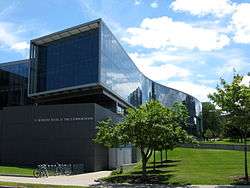
In its 2019 ranking of U.S. colleges, U.S. News & World Report ranked Syracuse tied for 53rd among undergraduate national universities.[120] Some of SU's programs have been nationally recognized for excellence. A 2019 survey in the Academic Ranking of World Universities places Syracuse University in the top 100 world universities in social sciences.[121][122] In the 2015 'Design Intelligence' national rankings, the Environmental and Interior Design program is ranked 9th. The School of Architecture's Bachelor of Architecture program was ranked 2nd nationally in 2010 by the journal DesignIntelligence in its annual edition of "America's Best Architecture & Design Schools." In 2019, Syracuse University was ranked 22nd in New York State by average professor salaries.[123][124] Syracuse was ranked 1st in The Princeton Review's 2015 and 2019 list of top party schools.[125][126]
The S.I. Newhouse School of Public Communications is one of the top ranked in the country and has produced alumni in many fields of broadcasting.[127] The school is exceptionally respected and well recognized worldwide for various offered programs.
The School of Information Studies offers information management and technology courses at the undergraduate and graduate levels at Syracuse University. Within the School of Information Studies, U.S. News & World Report has ranked the graduate program as the 3rd best Library and Information Studies graduate school in the United States. It also has the top-ranked graduate Information Systems program, the 2nd ranked graduate program in Digital Librarianship, and the 4th ranked graduate program in School Library Media.[128]
The School of Management was renamed the Martin J. Whitman School of Management in 2003, in honor of SU alumnus and benefactor Martin J. Whitman. The school is home to about 2,000 undergraduate and graduate students. The undergraduate program was ranked No. 43 among business schools nationwide by U.S. News & World Report in 2019[129] while the graduate school was ranked No. 70.[130] The entrepreneurship program was ranked No. 9 by the U.S. News & World Report in 2018, and No. 13 by both Entrepreneur Magazine and The Princeton Review in 2007. The supply chain management program was ranked No. 10 in the nation by Supply Chain Management Review. Also, the Joseph I. Lubin School of Accounting was named No. 10 in the nation by The Chronicle of Higher Education.[131]
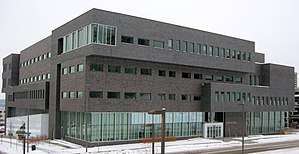
The College of Law is ranked 88th nationally by U.S. News & World Report. It is an emerging leader in the relatively novel field of National Security Law.[132] In 2007 the law school started the Cold Case Justice Initiative, investigating cold cases from the civil rights era in the South. Its professors and students have identified 196 cases, of which more than 100 are in Georgia, and will give information to the US Department of Justice to have cases prosecuted.[133] The FBI has identified 122 cold cases that it is trying to resolve.
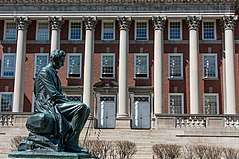
The Maxwell School of Citizenship and Public Affairs combines social sciences with public administration and international relations. It is ranked as the top and one of the most prestigious graduate school for public affairs in the US.[134]
.jpg)
Military Times ranks Syracuse University the top Private School for Vets and 4th Overall in the Best for Vets.[135][136][137] Syracuse University is ranked 26th in Best Colleges for Veterans by U.S. News & World Report in 2019.[138] In June 2011, the school launched the Institute for Veterans and Military Families (IVMF) to bring together several pre-existing veterans related institutes at the University.[139] The IVMF is higher education's first interdisciplinary academic institute, singularly focused on advancing the lives of the nation's military veterans and their families.[140] In an ongoing effort to position Syracuse University as the center of veteran life on the school's campus, in the local community, across Central New York; and the nation's hub of research and programming connected to the veteran and military sectors, the school made a commitment to build the $63 million state-of-the-art National Veterans Resource Center (NVRC).[141] The NVRC will be the first-of-its kind facility in the United States – and a class-leading exemplar of academic, government, and community collaboration – dedicated to advancing academic research, actionable programs, and community-connected innovation in service to the nation's veterans and military-connected families.[142] In 2020 the NVRC is expected to house the Institute for Veterans and Military Families, Syracuse University Office of Veteran and Military Affairs (OVMA), Army Reserve Officers' Training Corps (ROTC), Air Force Reserve Officer Training Corps (ROTC), Syracuse University & Regional Student Veterans Resource Center, S. Department of Veterans Affairs ‘Vet-Success on Campus’, Center of Excellence for Veteran Entrepreneurship, Veteran Business Outreach Center & Accelerator, flexible office and classroom spaces for local, county and state government veteran representatives and community-based veterans organizations, along with a conference center and auditorium suitable to host community activities, lectures, and national convening events and conferences.[143][144]
The graduate program of the College of Visual and Performing Art (VPA) is considered one of the top 50 programs in the US.[145] VPA ranked No. 14 in multimedia/visual communications, a specialty that includes disciplines found in the college's Department of Transmedia, which offers M.F.A. programs in art photography, art video, computer art and film. VPA also ranked No. 16 in ceramics, No. 19 in printmaking and No. 20 in sculpture, which are M.F.A. programs based in the Department of Art. Project Advance (or SUPA) is a nationally recognized concurrent enrollment program honored by the American Association for Higher Education, the Carnegie Foundation for the Advancement of Teaching, the National Commission on Excellence in Education, and the National Institute of Education.[146]
Faculty
Syracuse University has 1013 full-time instructional faculty, 96 part-time faculty, and 454 adjunct faculty. Approximately 86% of the full-time faculty have earned PhDs or professional degrees.[4] The current faculty includes scholars such as United States National Academy of Sciences member Jozef J. Zwislocki, Professor of Psychology, who developed mathematical models on the mechanics of the inner and middle ear; MacArthur Fellow Don Mitchell, Professor of Geography, who has developed studies in cultural geography; Bruce Kingma, Associate Provost and Kauffman Professor of Entrepreneurship, a pioneer in the field of information economics and online learning; Catherine Bertini, Professor of Practice in Public Administration, who has worked on the role of women in food distribution; Frederick C. Beiser, Professor of Philosophy, one of leading scholars of German idealism; Mary Karr, the Jesse Truesdell Peck Professor of Literature, who has received a Guggenheim Fellowship in poetry; John Caputo, the Thomas J. Watson Professor of Humanities, who founded weak theology; Sean O'Keefe, former chairman of Airbus Group, Inc. and former Secretary of the Navy; and political theorist Elizabeth F. Cohen.
Syracuse University Press
Syracuse University Press is a university press that is part of Syracuse University.[147] The areas of focus for the Press include Middle East studies, Native American studies, peace and conflict resolution, Irish studies and Jewish studies, New York State, television and popular culture, sports and entertainment. The Press was founded on August 2, 1943, by Chancellor William Pearson Tolley and benefactor Thomas J. Watson. It is a member of the Association of American University Presses.[148]
University lectures
Every year as a tradition, the university invites speakers from around the world, leading thinkers and practitioners in sustainability, advertising, redevelopment, human rights, journalism, and the environment. The lecturers are selected for their academic and public service excellence. The university lectures are supported by the university trustees, alumni, and friends.[149] Previous university lecturers have included Ishmael Beah, author of A Long Way Gone: Memoirs of a Boy Soldier; 45th vice president of the United States Al Gore; economist and Nobel Prize winner Muhammad Yunus; author and columnist William Safire; environmental justice advocate Majora Carter; and environmental law attorney Robert Kennedy Jr.[150]
Libraries
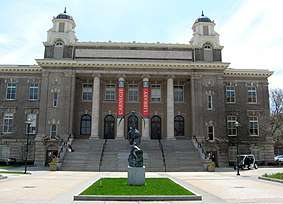
Syracuse University's main library is the Ernest S. Bird Library, which opened in 1972. Its seven levels contain 2.3 million books, 11,500 periodicals, 45,000 feet (14,000 m) of manuscripts and rare books, 3.6 million microforms, and a café.[151] There are also several departmental libraries on campus. Many of the landmarks in the history of recorded communication between people are in the university's Special Collections Research Center, from cuneiform tablets and papyri to several codices dating from the 11th century, to the invention of printing. The collection also includes works by Galileo, Luther, John Calvin, Voltaire, Isaac Newton, Descartes, Francis Bacon, Samuel Johnson, Thomas Hobbes, Goethe, and others. Other collections of note include Rudyard Kipling first editions and an original second leaf of the Gutenberg Bible.
In addition, the collection includes the personal library of Leopold Von Ranke. Making sensational headlines in 1887, the university outbid the Prussian government for all 19 tons of Von Ranke's prized personal library.[152][153]
Bird Library is also home to the largest collection of national archives of Kenya and Tanzania. In July 2008, Syracuse University became the owner of the second largest collection of 78 rpm records in the United States after the Library of Congress after a donation of more than 200,000 records. The donation is valued at $1 million and more than doubles the university's collection of 78 rpm records to about 400,000.[154][155] It also has a special Harriet Tubman Research Collection and an Environmental Justice and Gender collection housed in the Martin Luther King Jr. Memorial Library. The MLK library holds over 15,000 acquisitions in African, African-American, Afro-Latino, and Caribbean studies.
The university is also home to the Belfer Audio Laboratory and Archive, whose holdings total approximately 540,000 recordings in all formats, primarily cylinders, discs, and magnetic tapes. Some of the voices to be found include Thomas Edison, Amelia Earhart, Albert Einstein, and Oscar Wilde.[156][157]
Research
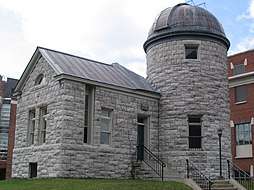
Syracuse is classified among "R1: Doctoral Universities – Very High Research Activity".[94] According to the National Science Foundation, Syracuse spent $148 million on research and development in 2018, ranking it 135th in the nation.[159] Through the university's Office of Research, which promotes research, technology transfer, and scholarship, and its Office of Sponsored Programs, which assists faculty in seeking and obtaining external research support, SU supports research in the fields of management and business, sciences, engineering, education, information studies, energy, environment, communications, computer science, public and international affairs, and other specialized areas.[160] Syracuse became a member of the Association of American Universities (AAU) in 1966, an organization of leading research universities devoted to maintaining a strong system of research and education.[161] In 2011, however, the university's board of trustees voted to pull out of the research consortium due to dispute over the counting of non-Federal research dollars.[162]
SU has established 29 research centers and institutes that focuses research, often across disciplines, in a variety of areas.[163] The Burton Blatt Institute advances research in economic and social issues for individuals with disabilities, and it has international projects in the field.[164] The Martin J Whitman School of Management supports the largest number of research centers, including The Ballentine Investment Institute, the George E. Bennett Center for Accounting and Tax Research, the Robert H. Brethen Operations Management Institute, Michael J. Falcone Center for Entrepreneurship, The H. H. Franklin Center for Supply Chain Management, Olivia and Walter Kiebach Center for International Business Studies, and the Earl V. Snyder Innovation Management Program. In 2010, the university launched SURFACE, an online, open-access institutional repository for research, which is ran by the Syracuse University Library System.[165]
Other research programs include The Syracuse Biomaterials Institute,[166] the Alan K. Campbell Public Affairs Institute through the Maxwell School, and the Center for the Study of Popular Television through the Newhouse School of Public Communications.[163]
Syracuse University also has collaborations with CERN and Fermi National Accelerator Laboratory, among other institutes. Syracuse also has a comparatively large number of collaborators on the LIGO Scientific project and is actively involved with the search for gravitational waves using data from the gravitational-wave detectors.[167][168][169]
Student life
| Undergraduate | Graduate | New York[172] | U.S. Census[172] | |
|---|---|---|---|---|
| African American | 6.2% | 6.5% | 17.6% | 13.4% |
| Asian American | 6.4% | 3.6% | 9.0% | 5.9% |
| Non-Hispanic White American | 56.1% | 37.9% | 55.3% | 60.1% |
| Hispanic-Latino American | 9.5% | 5.7% | 19.3% | 18.5% |
| Native American | 0.6% | 0.3% | 1% | 1.3% |
| International student | 14.6% | 41.7% | N/A | N/A |
| Two or more races | 3.4% | 1.9% | 2.7% | 2.8 |
| Unknown | 3.1% | 2.3% | N/A | N/A |
Syracuse University has a diverse student population, representing all 50 US states and over 115 countries. Approximately 10 percent of students are from outside of the US, and are supported by an international services department within the university's Division of Student Affairs.[173] Approximately 56% of that class are women.[174] In 2014, 8.8% of the students were black or African-American.[175]
Media
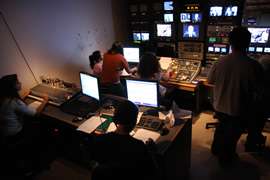
CitrusTV (formerly UUTV, HillTV and Synapse) is the university's entirely student-run television studio, and one of the largest student-run TV studios in the country with over 300 active members.[176] There are also multiple student-run magazines and other print publications, including: The Onondagan Yearbook, The Daily Orange, Student Voice, Perception, Jerk Magazine, What the Health, 360, Baked Magazine, The Out Crowd, and Equal Time.[177]
Student government
Founded in 1957, the Student Association (SA) represents the undergraduate students of both SU and ESF. SA, elects a President and Vice President (on a unified ticket) each academic year. They also each year elect a Comptroller, who, with the assembly, oversees the allocation and designation of the Student Activity Fee that was first collected in the 1968–69 school year. The goals of SA are to participate through a unified student voice in the formulation of Syracuse University rules and regulations. The SA-SGA Alumni Organization maintains the history and an organizational timeline on its website.[178]
The graduate students at Syracuse University are represented by the Graduate Student Organization (GSO) while the law students at Syracuse University are represented by the Law Student Senate. Each of the three organizations elects students to serve in the Syracuse University Senate, which also includes faculty, staff, and administrators.[179]
Fraternities and sororities
The Syracuse University fraternity and sorority system offers organizations that are members of the Panhellenic Council (NPC), the Interfraternity Council (IFC), the National Association of Latino Fraternal Organizations, the National Multicultural Greek Council, the Professional Fraternity Council (PFC), and the National Pan-Hellenic Council (NPHC). In addition to SU students, ESF students are permitted to join the university's fraternity and sorority system.
The oldest fraternity at SU is Delta Kappa Epsilon, which established a chapter in 1871 soon after the founding of the university, followed by Psi Upsilon in 1875 and Phi Kappa Psi in 1884.[180] Sororities were also a part of the early history of SU. Alpha Phi was founded at SU in 1872, followed by Gamma Phi Beta in 1874 (first organization to use the term "sorority"),[181] and Alpha Gamma Delta in 1904. Alpha Phi Alpha established a chapter at SU in 1910, and was reorganized in 1949 and 1973. The first NPHC fraternity,[182] Omega Psi Phi, was established at SU in 1922, and the first NPHC sorority, Delta Sigma Theta in 1973.[180] Alpha Phi Delta, the only historically Italian-American heritage fraternity, was founded at SU in 1914. University policy prohibits fraternities and sororities from discriminating "on the basis of race, creed, color, gender, national origin, religion, marital status, age, disability, sexual orientation, or status as a disabled veteran or a veteran of the Vietnam era."[183]
Syracuse University Ambulance
Syracuse University Ambulance,[184] commonly referred to as SUA, is a SU Health Services-based student organization that responds to over 1,500 medical emergencies each year. Providing intermediate life support (ILS), rapid cardiac defibrillation, emergency and nonemergency transportation, and special event standby services, SUA operates two full-time transporting ambulances, a supervisor's fly car, and a MCI trailer for mass-casualty incidents. Additionally, SUA operates four transport vans for non-emergency transports. Advanced life support (ALS) mutual aid is provided by the City of Syracuse's private EMS provider, American Medical Response (AMR). SUA was formed in 1973 by a group of students out of a need for emergency medical services on campus. Starting with only a few members and meager equipment, the Syracuse University Medical Crisis Unit was formed. The organization has evolved greatly over time but, with 70+ volunteer students, remains a student-run organization to this day. SUA provides emergency and non-emergency services 24 hours a day, 7 days a week during the academic school year and is funded by a portion of the student health fee.
Religious life
Hendricks Chapel[185] is an interfaith chapel located on the Quad, and serves as the spiritual center of Syracuse University. The Chapel is home to ten chaplaincies, including Baptist, Buddhist, Evangelical Christian, Historically Black Churches, Islamic, Jewish, Lutheran, Pagan, Methodist, and Roman Catholic.[186] In addition, there are a number of student religious groups, including groups associated with the chaplaincies as well as Adventist, Christian Science, Hindu, Mormon, Muslim, Orthodox Christian, Pentecostal, and more.[187]
Additional buildings located on campus support specific religious groups, including the Alibrandi Catholic Center[188] and the Winnick Hillel Center for Jewish Life.[189] Off campus, the Chabad House[190] and Islamic Society of CNY also support student religious life.
Athletics

Syracuse University's sports teams have had "the Orange" nickname since 2004, although the former names of Orangemen and Orangewomen are still used. The school's mascot is Otto the Orange. SU fields intercollegiate teams in eight men's sports and 12 women's sports. The men's and women's basketball teams, the football team, and both the men's and women's lacrosse teams play in the Carrier Dome. Other sports are located at the nearby Manley Field House, except ice hockey which takes place in the Tennity Ice Skating Pavilion. Most of Syracuse University's intercollegiate teams participate in NCAA Division I in the Atlantic Coast Conference since 2013.[191] The Syracuse Orange women's ice hockey team participates in College Hockey America.
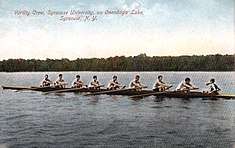
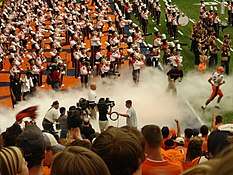
Syracuse University rowing crew is a full member of the Intercollegiate Rowing Association (IRA). The IRA governs intercollegiate rowing between varsity rowing programs across the United States. It is the direct successor to the Rowing Association of American Colleges, the first collegiate athletic organization in the United States, which operated from 1870 to 1894. The IRA was founded by Cornell, Columbia, and Penn in 1894 and its first annual regatta was hosted on June 24, 1895. Today Navy and Syracuse are also part of the association. Each year these five schools choose whom to invite to the IRA National Championship Regatta and are responsible for its organization. Syracuse crew also participates in the Eastern Association of Rowing Colleges.
SU has reached 31 team national championships, including 14 men's lacrosse, six men's crew, two cross country running, and one each in boxing, football, women's lacrosse, and women's field hockey.[192] Under long-time the Hall of Fame head coach Jim Boeheim, men's basketball team won seven Big East regular season championships, five Big East Tournament championships, and 25 NCAA Tournament appearances, including the 2003 NCAA championship. The men's basketball team holds the largest on campus attendance record of 35,446 attendees. The record was set in the Carrier Dome playing Duke on Saturday February 1, 2014.
In 1959, Syracuse earned its first National Championship following an undefeated football season and a Cotton Bowl victory over Texas. The team featured sophomore running back Ernie Davis who, in 1961, became the first African-American to win the Heisman Trophy. Davis was slated to play for the Cleveland Browns in the same backfield as Jim Brown, but died of leukemia before being able to play professionally.[193]

Syracuse played its first intercollegiate lacrosse game in 1916, and captured its first USILA championship in 1920.[194] It won USILA championships in 1922, 1924, and 1925. In the modern NCAA era, Syracuse is the first school to capture 11 National Championships, the most of any team in college lacrosse history. Most recently, Syracuse reached the men's Division I championship game in 2013 after winning two championships in 2008 & 2009 seasons and reaching the quarterfinals in 2011.[195][196] The women's lacrosse team reached the NCAA Division I National Championship game for the first time in school history in 2012, which they lost to Northwestern.[197]
Toward the end of the 1970s, Syracuse University was under pressure to improve its football facilities to remain a NCAA Division I football school. Its small concrete stadium, Archbold Stadium, was seventy years old and not up to the standards of other schools. The stadium could not be expanded; it had been reduced from 40,000 seats to 26,000 due to the fire codes. Syracuse University decided to build a new stadium. In 1978, Archbold Stadium was demolished to make way for the Carrier Dome, which was to have a domed Teflon-coated, fiberglass inflatable roof. It would also serve as the home for the men's basketball team, as a replacement for Manley Field House. The Carrier Dome was constructed between April 1979 and September 1980.[198][199]
In May 2018, Syracuse University made an announcement of $120 million investment to renovate the Carrier Dome. A new fixed roof, a vertically hung scoreboard, state-of-the-art sound and lighting systems, improved accessibility, upgraded concessions, air conditioning and added Wi-Fi capabilities are just a handful of features visitors, students, faculty, staff, alumni and fans of Syracuse University will experience beginning in fall 2020.[200]
Syracuse University hosted the 2019 United States Intercollegiate Boxing Association national championship tournament.[201]
Alumni
Syracuse University has over 250,000 alumni representing all 50 states, the District of Columbia, and more than 170 countries and territories.[202] Among the individuals who have attended or graduated from Syracuse University include writers George Saunders, Stephen Crane, Joyce Carol Oates, John D. MacDonald, Cheryl Strayed, Shirley Jackson, and Alice Sebold; William Safire, Pulitzer Prize winning commentator; Pierre Ramond, string theorist; Cambridge University historian Sir Moses I. Finley; Sir John Stanley, British Member of Parliament; Arthur Rock, legendary venture capitalist and cofounder of Intel; Vishal Sikka, Former CEO and MD of Infosys; Donna Shalala, CEO of the Clinton Foundation; Joe Biden, former Vice President of the United States; Robert Jarvik, inventor of the first artificial heart implanted into human beings; Eileen Collins, first female commander of a Space Shuttle; Prince Sultan bin Salman, first Arab, first Muslim and the youngest person to travel to space; Robert Menschel, partner/director at Goldman Sachs; Marilyn Loden, who coined the phrase "glass ceiling"; Samuel Irving Newhouse Jr., owner of Conde Nast publications; Lowell Paxson, founder of Home Shopping Network; Betsey Johnson fashion designer; David P. Weber, lawyer and Certified Fraud Examiner, who reported misconduct in the Bernard L. Madoff and R. Allen Stanford frauds; Abramoff scandal lawyer Kevin Ring, and Prince Al-Waleed bin Talal, a prominent investor and member of the Saudi royal family. Emily C. Gorman, former director of the United States Women's Army Corps, completed her graduate studies at Syracuse.
Alumni in journalism and broadcasting include Ted Koppel, Megyn Kelly, Michael Barkann, Bob Costas, Marv Albert, Len Berman, Marc S. Ellenbogen, Marty Glickman, Dorothy Thompson, Beth Mowins, Dave Pasch, Sean McDonough, Ian Eagle, Dave O'Brien, Dick Stockton, Arun Shourie, Mike Tirico, Brian Higgins, Adam Zucker, Lakshmi Singh, Larry Hryb (an employee at Microsoft, former radio broadcaster for Clear Channel Communications), Steve Kroft of 60 Minutes, Pulitzer Prize winner Eugene Payne and Adam Schein of Mad Dog Sports Radio, Vietnam war historian and correspondent Bernard Fall, national political columnist Roscoe Drummond, Jeff Glor, CBS News anchor, Vijay Kumar Pandey, Nepalese Columnist and TV personality.
Notable SU alumni in the performing arts and art include Dick Clark, Taye Diggs, Rob Edwards, Peter Falk, Vera Farmiga, Peter Guber, Peter Hyams, Frank Langella, Jessie Mueller, Lou Reed, Tom Everett Scott, Aaron Sorkin, Jerry Stiller, Lexington Steele, Bill Viola, Vanessa Williams, Pete Yorn, and artist Susan Sensemann.
Prominent athletes include Kathrine Switzer, the first woman to officially run the Boston Marathon, Jim Brown, actor and NFL Hall of Famer with the Cleveland Browns, arguably the greatest running back of all time;[203] Ernie Davis, the first African-American Heisman Trophy winner immortalized in the motion picture The Express: The Ernie Davis Story; Donovan McNabb, former NFL quarterback; former Indianapolis Colts wide receiver Marvin Harrison; Dwight Freeney, defensive end for the San Diego Chargers; Larry Csonka, former Miami Dolphins running back, Pro Football Hall of Famer and television host, Carmelo Anthony, forward for Syracuse's NCAA men's baskethall championship squad and NBA veteran; 7-time NBA All Star, pro basketball Hall of Famer and former Mayor of Detroit Dave Bing; Tim Green, former Atlanta Falcons player, author, lawyer, and National Public Radio commentator; Darryl Johnston, three-time Super Bowl winner with the Dallas Cowboys in the 1990s; Mikey Powell, who formerly played lacrosse for the Boston Cannons; Floyd Little, who played for the Denver Broncos; Kyle Johnson, who played the majority of his NFL career with the Denver Broncos; John Mackey a member of the NFL Hall of Fame played for the legendary Baltimore Colts (1963–71); and Tom Coughlin, former New York Giants head coach and executive VP of football operation at Jacksonville Jaguars.
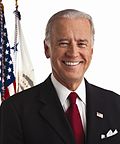 Joe Biden G’68, 47th vice president of the United States
Joe Biden G’68, 47th vice president of the United States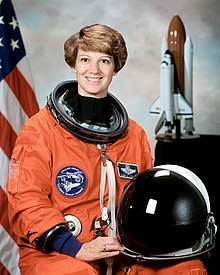 Eileen Collins '78, the first female Space Shuttle pilot and commander
Eileen Collins '78, the first female Space Shuttle pilot and commander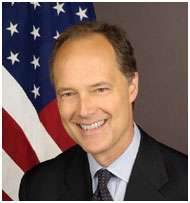 James B Cunningham ’74, American diplomat and former ambassador to Afghanistan
James B Cunningham ’74, American diplomat and former ambassador to Afghanistan.jpg) Arthur Rock '48, American businessman and investor
Arthur Rock '48, American businessman and investor- Dick Clark ’51, American radio and television personality


 Jim Brown '57, Football Hall of Fame halfback
Jim Brown '57, Football Hall of Fame halfback_(cropped).jpg) Megyn Kelly ’92, American journalist, political commentator, and news anchor
Megyn Kelly ’92, American journalist, political commentator, and news anchor- Mike Tirico ’88, American sportscaster
- Bob Costas ’74, American sportscaster
 Vanessa Williams '86, national recording artist and actor
Vanessa Williams '86, national recording artist and actor Drew Taggart '12, member of the Grammy-Award winning group The Chainsmokers
Drew Taggart '12, member of the Grammy-Award winning group The Chainsmokers
Affiliations
Affiliated institutions
State University of New York College of Environmental Science and Forestry
The College of Environmental Science and Forestry (ESF) has a long affiliation with Syracuse University, shares many campus resources, and operates its main academic campus immediately adjacent to Syracuse University. ESF was founded in 1911 as the New York State College of Forestry at Syracuse University, under the leadership of Syracuse University Trustee Louis Marshall, with the active support of Syracuse University Chancellor Day. Its founding followed the Governor's veto of annual appropriations to a separate New York State College of Forestry at Cornell.[204]
ESF is an autonomous institution, administratively separate from SU, while resources, facilities, and some infrastructure are shared. The two schools share a common Schedule of Classes; students at both institutions may take courses at the other, and degrees from ESF bear the Syracuse University seal along with the State University of New York. A number of concurrent degree programs and certificates are offered between the schools, as well. The college receives an annual appropriation as part of the SUNY budget and the state builds and maintains all of the college's educational facilities. The state has similar relationships with five statutory colleges that are at Alfred University and Cornell University.
ESF faculty, students, and students' families join those from SU to take part in a joint convocation ceremony at the beginning of the academic year in August, and joint commencement exercises in May. ESF and SU students share access to libraries, recreational facilities, student clubs, and other activities at both institutions, except for the schools' intercollegiate sports teams, affiliated with the NCAA and USCAA, respectively. First-year ESF students live in Centennial Hall on ESF's campus.[205]
State University of New York Upstate Medical University
The medical school was formerly a college within SU, known as the Syracuse University Medical School. In 1950, SU sold the medical school to the State University of New York system.[206] A joint Master of Public Health degree program[207] and a joint PhD Program in Biomedical Engineering are offered by the two institutions. The campuses of the two universities are adjacent to each other on University Hill in Syracuse.
Formerly affiliated institutions
State University of New York at Binghamton
Binghamton University was established in 1946 as Triple Cities College, to serve the needs of local veterans of the Binghamton, New York area, who were returning from World War II. Established in Endicott, New York, the college was a branch of Syracuse University. Triple Cities College offered local students the first two years of their education, while the following two were spent at Syracuse University. In 1946, students could earn their degrees entirely at the Binghamton campus. In 1950, it was absorbed by the State University of New York and renamed Harpur College.[208]
Utica College
Utica College, an independent private university located in Utica, New York, was founded by Syracuse University in 1946. Utica College became independent from Syracuse in 1995, but still offers its students the option to receive a specialized bachelor's degree from Syracuse University through a mutual relationship between the two schools.[209]
See also
- Feiner v. New York
- List of Chancellors of Syracuse University
- Say Yes to Education
- Syracuse University Alma Mater
- Syracuse University in pop culture (movies, books, television)
References
- "150 Years Timeline". Syracuse University.
- As of June 30, 2019. "U.S. and Canadian 2019 NTSE Participating Institutions Listed by Fiscal Year 2019 Endowment Market Value, and Percentage Change in Market Value from FY18 to FY19 (Revised)". National Association of College and University Business Officers and TIAA. Retrieved April 21, 2020.
- Budget 2019 "Syracuse University's goals: Raise $1.5 billion and its academic profile". Syracuse.com. 2019. Archived from the original on November 9, 2019. Retrieved November 9, 2019.
- "SU Facts". Syracuse University. Archived from the original on November 29, 2010. Retrieved January 29, 2011.
- "Syracuse University OIRA – Facts and Figures – Student Enrollment" (PDF). Syracuse University. October 2, 2019. Archived (PDF) from the original on November 1, 2019. Retrieved November 1, 2019.
- "Syracuse University Business and Facilities Maintenance Services". Syracuse University. Archived from the original on January 28, 2013.
- Syracuse University Brand Guidelines. Retrieved March 24, 2020.
- "Marrone's Focus is on the 'Cuse". Syracuse University. December 13, 2008. Archived from the original on October 16, 2015. Retrieved January 5, 2009.
- "Syracuse University | US News". Colleges.usnews.rankingsandreviews.com. September 28, 2012. Archived from the original on October 13, 2012. Retrieved October 10, 2012.
- "Syracuse University". Princetonreview.com. September 22, 2013. Archived from the original on December 30, 2013. Retrieved December 29, 2013.
- "Syracuse University – School Overview". Cappex. Archived from the original on May 30, 2012. Retrieved October 10, 2012.
- "Syracuse University". March 28, 2011. Archived from the original on July 28, 2013. Retrieved April 4, 2012.
- "Syracuse University Bylaws, Scope: Trustees/University Governance". Syracuse University. May 14, 2011. Archived from the original on January 30, 2012. Retrieved December 16, 2011.
Three Trustees shall be elected by the Board to represent the North Central New York, Western New York and Wyoming Conferences of the United Methodist Church. The Syracuse University Board of Trustees and the named conferences may recommend persons for election as Trustees in this capacity. The representatives need not reside in the areas they represent.
- A Brief Report of Church Relatedness: Syracuse University – INCORPORATION AND THE METHODIST CHURCH. Syracuse University. June 15, 2010.
The current bylaws authorize the Board to elect three Organization Trustees: one Trustee each to represent the North Central New York, Western New York, and Wyoming conferences of the United Methodist Church. Both the conferences and the Board may recommend persons for election as Organization Trustees. Today Syracuse University is considered a Methodist-related institution. Syracuse University's affiliation is expressed in the tradition, though not regulation, of having a United Methodist minister serve as dean of Hendricks Chapel and in the University's participation in the annual University Teacher/Scholar Award sponsored by the Methodist Church. In addition, the University administers a number of Methodist-funded scholarships and houses the Bishop Ledden Endowed Professorship in the Department of Religion.
- Separated brethren: a review of Protestant, Anglican, Eastern Orthodox & other religions in the United States. Our Sunday Visitor. 2002. ISBN 9781931709057. Retrieved March 27, 2010.
Among Protestant denominations, Methodists take first place in hospitals and colleges. Some of their one hundred colleges and universities have all but severed ties with the denominations, but others remain definitely Methodist: Syracuse, Boston, Emory, Duke, Drew, Denver, and Southern Methodist. The church operates three hundred sixty schools and institutions overseas. Methodists established Goodwill Industries in 1907 to help handicapped persons help themselves by repairing and selling old furniture and clothes. The United Methodist Church runs seventy-two hospitals in the United States.
- "Syracuse University". International Association of Methodist Schools, Colleges, and Universities (IAMSCU). Archived from the original on July 23, 2011. Retrieved June 30, 2007.
- "United Methodist schools score high in rankings". The United Methodist Church. August 31, 2004. Archived from the original on July 1, 2012. Retrieved June 30, 2007.
Other United Methodist schools on the top national list are Syracuse (N.Y.) University (tied for 52nd); Boston University (tied for 56th); Southern Methodist University, Dallas (tied for 71st); and American University, Washington (tied for 86th).
- Thamel, Pete (September 18, 2011). "College Football – Syracuse and Pittsburgh Join A.C.C." The New York Times. ISSN 0362-4331. Archived from the original on May 29, 2019. Retrieved May 29, 2019.
- "Membership – IRA National Championship Regatta". Archived from the original on May 29, 2019. Retrieved May 29, 2019.
- "Syracuse women's hockey reaches NCAA tournament for 1st time in school history". syracuse.com. March 9, 2019. Archived from the original on May 29, 2019. Retrieved May 29, 2019.
- "Eastern College Athletic Conference (ECAC)". Easter College Athletic Conference. September 29, 2008. Archived from the original on February 3, 2015. Retrieved September 16, 2008.
- "Genesee Wesleyan Seminary Collection An inventory of the collection at the Syracuse University Archives". library.syr.edu. Archived from the original on May 29, 2019. Retrieved May 29, 2019.
- "University Archives | Syracuse University Libraries". library.syr.edu. Archived from the original on September 24, 2018. Retrieved September 24, 2018.
- "Syracuse and A Civil War Masterpiece : Syracuse University Magazine". sumagazine.syr.edu. Archived from the original on September 28, 2018. Retrieved January 4, 2020.
- "University Archives | Syracuse University Libraries". library.syr.edu. Archived from the original on September 24, 2018. Retrieved September 24, 2018.
- "University Archives: Syracuse University Libraries". library.syr.edu. Retrieved September 24, 2018.
- "University Archives: Syracuse University Libraries". library.syr.edu. Archived from the original on September 24, 2018. Retrieved September 24, 2018.
- Galpin, WF (1952). Syracuse University: The Pioneer Years. Syracuse, NY: Syracuse University Press.
- Greene, John Edward (2000). The Hill: an illustrated biography of Syracuse University (SU), 1870–present. Syracuse: Syracuse University Press. ISBN 0-8156-0648-6.
- Goldwin Smith, Reminiscences (New York, 1911), p.371;quoted in Morris Bishop (1962), p.11, A History of Cornell. Cornell University Press
- Carol Kammen, 2003, p. 13 "Glorious to View Cornell", Cornell University Press; Ithaca, NY ISBN 978-0-935995-03-9
- "History of the Founding of Syracuse University". Syracuse University. Archived from the original on September 27, 2011. Retrieved December 15, 2010.
- "Peck at Dickinson". Archived from the original on July 28, 2008. Retrieved August 26, 2009.
- Green, John Edward (2000). The Hill: an illustrated biography of Syracuse University, 1870–present. Syracuse: Syracuse University Press. p. 2. ISBN 0-8156-0648-6.
- Gorney, J (2006). Syracuse University: an architectural guide. Syracuse, NY: Syracuse University Press. ISBN 0-8156-0810-1.
- "Co-ed From the Start: Women Students at Syracuse University in the 19th Century". Syracuse University. Archived from the original on June 9, 2010. Retrieved December 20, 2010.
- Becque, Fran (August 12, 2013). "Women's Fraternities, Sororities, and Dr. Frank Smalley". Fraternity History & More. Retrieved May 17, 2020.
- "University Archives Syracuse University Libraries". library.syr.edu. Archived from the original on September 24, 2018. Retrieved September 24, 2018.
- "SU Archives: Buildings – Tolley Building". archives.syr.edu. Archived from the original on April 26, 2017. Retrieved May 15, 2017.
- "SU Archives: Buildings – Crouse College of Fine Arts". archives.syr.edu. Archived from the original on May 20, 2017. Retrieved May 15, 2017.
- Baron, Karrie A.; Galpin, William Freeman; Wilson, Richard; Barck, Oscar Theodore; Greene, John Edward (1952). Syracuse University. Syracuse: Syracuse University Press. ISBN 0-8156-2701-7.
- "Syracuse University History". Syracuse University. Archived from the original on October 20, 2008. Retrieved September 17, 2008.
- "Syracuse University History 1906–1930". Syracuse University. Archived from the original on September 17, 2008. Retrieved September 17, 2008.
- "History and Overview – Syracuse University Whitman School of Management". whitman.syr.edu. Archived from the original on June 20, 2018. Retrieved June 19, 2018.
- "Syracuse University History 1931–1950". Syracuse University. Archived from the original on July 24, 2008. Retrieved September 17, 2008.
- Forbes, BC (1917). Men who are making America. New York, NY: B.C. Forbes Publishing. p. 440.
- "University Archives: Syracuse University Libraries". library.syr.edu. Retrieved September 24, 2018.
- "Syracuse University History, 1951–1960". Syracuse University. Archived from the original on July 24, 2008. Retrieved October 6, 2008.
- "Syracuse University History, 1961–1970". Syracuse University. Archived from the original on July 24, 2008. Retrieved October 6, 2008.
- Deppa, Joan (1994). The media and disasters: Pan Am 103. New York: New York University Press. ISBN 0-8147-1856-6.
- Yen, Marianne (December 23, 1988). "A Tragic End to the Semester". The Washington Post. p. A07.
Eggers was criticized for allowing a basketball game against Western Michigan to be played here Wednesday night. More than 25,000 people attended, and a moment of silence was observed before the game. 'We who are in charge were also in shock,' a haggard Eggers explained yesterday. 'The question of the basketball game just dropped by the wayside in our efforts to deal with this tragedy.'
- Kaye, Ken (December 21, 2003). "An Act of War?–On the 15th Anniversary a Former Pilot Compares the Downing of Pan Am 103 to the Sept. 11, 2001 Attacks on America". South Florida Sun-Sentinel. p. 3A.
Until Sept. 11, Flight 103 had been the deadliest act of terrorism against the United States, killing...189 Americans.
- Conery, Ben (December 21, 2008). "20 years later, pain of Lockerbie still fresh". The Washington Times. p. A3.
When a bomb hidden aboard Pan Am flight 103 exploded over Lockerbie, Scotland...189 Americans (were) killed, making it the largest terrorist attack against the U.S. until nearly 3,000 people were killed Sept. 11, 2001.
- "Lockerbie Scholars". Syracuse University. Archived from the original on July 25, 2008. Retrieved October 6, 2008.
- Lauren del Valle. "Their fraternity is expelled. They're removed from classes. And another disturbing Syracuse frat video surfaces". CNN. Archived from the original on December 10, 2019. Retrieved November 20, 2019.
- McMahon, Julie (January 9, 2019). "Theta Tau scandal: Judge upholds Syracuse University suspensions of frat brothers". syracuse. Archived from the original on December 10, 2019. Retrieved November 20, 2019.
- "White supremacist manifesto shared at library, students say, as racist incidents roil Syracuse University". Washington Post. Archived from the original on November 20, 2019. Retrieved November 20, 2019.
- Carter, Sam (November 18, 2019). "Fraternity at Syracuse University suspended after allegations of racist language". WSTM. Archived from the original on December 10, 2019. Retrieved November 20, 2019.
- Randle, Aaron; McKinley, Jesse (November 19, 2019). "Racist Manifesto Lands on Syracuse Students' Phones, Deepening Crisis". The New York Times. ISSN 0362-4331. Archived from the original on November 20, 2019. Retrieved November 20, 2019.
- Gelfand, Sam (November 20, 2019). "Syracuse Students Flee Campus Rocked by Racist Incidents". Archived from the original on November 21, 2019. Retrieved November 20, 2019.
- Leffert, Catherine (November 21, 2019). "Syracuse police find no devices that received white supremacist manifesto so far". The Daily Orange. Retrieved November 22, 2019.
- "Reports of racist manifesto at Syracuse University likely a hoax, chancellor says". CBS News. November 21, 2019. Archived from the original on November 22, 2019. Retrieved November 22, 2019.
- Aratani, Lauren (November 21, 2019). "Syracuse students call for chancellor to quit over racist incidents on campus". The Guardian. Archived from the original on November 22, 2019. Retrieved November 22, 2019.
- "Institute on Communication and Inclusion". soe.syr.edu. Syracuse University School of Education. Archived from the original on September 7, 2018. Retrieved September 7, 2018.
- "Syracuse University's reinforcement of facilitated communication inexcusable, concerning". The Daily Orange. Archived from the original on April 15, 2016. Retrieved September 7, 2018.
- Ali Shehad Zaidi, "Powerful Compassion: The Strike At Syracuse," in Monthly Review, September 1999
- "Best Places to Live-Syracuse, NY". CNNMoney. August 2008. Archived from the original on January 23, 2009. Retrieved January 6, 2009.
- "With dormitory space scarce, Syracuse University places students in hotels, off-campus apartments". syracuse. October 3, 2011. Archived from the original on January 31, 2020. Retrieved January 31, 2020.
- "Drumlins Country Club. Syracuse, New York". Drumlins Country Club. Archived from the original on August 21, 2008. Retrieved October 6, 2008.
- "Lubin House: Welcome". Syracuse University. Archived from the original on October 14, 2008. Retrieved October 6, 2008.
- "Syracuse University Greenberg House". Syracuse University. Archived from the original on September 25, 2008. Retrieved October 6, 2008.
- "Minnowbrook Conference Center". Minnowbrook Conference Center. Archived from the original on September 25, 2008. Retrieved October 6, 2008.
- "University Archives | Syracuse University Libraries". library.syr.edu. Archived from the original on September 25, 2018. Retrieved September 24, 2018.
- "University Archives | Syracuse University Libraries". library.syr.edu. Retrieved September 24, 2018.
- "Syracuse University Map". Syracuse University. Archived from the original on August 1, 2008. Retrieved September 20, 2008.
- Robert Mann & Alice Jean Stuart (1980). "National Register of Historic Places Inventory/Nomination: Syracuse University-Comstock Tract Buildings". Archived from the original on July 24, 2011. Retrieved January 25, 2008.
- "National Register Information System". National Register of Historic Places. National Park Service. January 12, 2009. Archived from the original on July 25, 2008. Retrieved January 13, 2010.
- "Syracuse Center of Excellence in Environmental and Energy Innovations". SyracuseCoE. 2008. Archived from the original on March 2, 2009. Retrieved January 6, 2009.
- "Excellence in Environmental and Energy Innovations". Syracuse University. Archived from the original on October 16, 2015. Retrieved December 25, 2010.
- "Welcome to Syracuse University News". Syracuse University. Archived from the original on November 24, 2007. Retrieved September 24, 2008.
- Gibson, Tom. "Orange Lead the Way". Progressive Engineer. Archived from the original on December 11, 2013. Retrieved December 3, 2013.
- "The Connective Corridor—Project Overview". Syracuse University. 2008. Archived from the original on February 7, 2009. Retrieved January 6, 2009.
- "Syracuse in Your Area – Syracuse University". syracuse.edu. Archived from the original on August 4, 2018. Retrieved May 15, 2017.
- "Maxwell partners with think tank to establish master's degree program tailored to working professionals". The Daily Orange – The Independent Student Newspaper of Syracuse, New York. October 23, 2017. Retrieved February 13, 2020.
- "Educational Programs at CSIS- Center for Strategic and International Studies". www.csis.org. Retrieved February 13, 2020.
- "Syracuse University Art Galleries Now Known as Syracuse University Art Museum". SU News. May 29, 2020. Retrieved June 1, 2020.
- "The Warehouse Gallery". Archived from the original on March 20, 2014.
- "Lubinhouse.syr.edu". Archived from the original on March 20, 2014.
- "Lowe Art Gallery: Syracuse Arts Directory". Archived from the original on September 24, 2015. Retrieved August 3, 2015.
- "Art Exhibits Policy". Archived from the original on September 5, 2015. Retrieved August 3, 2015.
- "Galleries". Archived from the original on July 22, 2015. Retrieved August 3, 2015.
- "Special Collections Research Center". Archived from the original on August 12, 2015. Retrieved August 3, 2015.
- "Syracuse University Bylaws". Archived from the original on June 9, 2010. Retrieved November 15, 2010.
- "Institutions: Syracuse University". Carnegie Foundation. Archived from the original on July 21, 2015. Retrieved July 16, 2015.
- "Office of Admissions". Syracuse University. Archived from the original on September 28, 2013. Retrieved September 16, 2008.
- "For Second Year in a Row, University Receives Record Number of First-Year Applications". SU News. Retrieved January 26, 2020.
- "Incoming Class Distinguished by Highest Average SAT Score in Institution's History, Significant Spike in Applications Leads to One of the Most Academically Competitive Classes to Date". SU News. Retrieved January 26, 2020.
- "Syracuse University College Scorecard". collegescorecard.ed.gov. Archived from the original on December 22, 2017. Retrieved January 26, 2020.
- US Department of Education (February 26, 2020). "Distribution of Federal Pell Grant Program Funds by Institution and Award Year". www2.ed.gov. Retrieved April 29, 2020.
- "Syracuse University". Middle States Commission on Higher Education. Retrieved July 31, 2020.
- "Office of Admissions". Syracuse University. Archived from the original on September 29, 2013. Retrieved September 16, 2008.
- "Online MBA Program – Syracuse University". Archived from the original on June 15, 2018. Retrieved June 19, 2018.
- "Certificates of Advanced Study | iSchool@Syracuse". ischoolonline.syr.edu. Archived from the original on December 23, 2019. Retrieved January 31, 2020.
- "Certificates of Advanced Study | Maxwell School". The Maxwell School of Syracuse University. August 11, 2018. Retrieved January 31, 2020.
- "Certificates of Advanced Study | Syracuse University School of Education". July 17, 2018. Archived from the original on January 31, 2020. Retrieved January 31, 2020.
- "SU Abroad – Programs By Location". Syracuse University. Archived from the original on October 13, 2008. Retrieved October 6, 2008.
- "SU Abroad – Your Place in the World". Syracuse University. Archived from the original on September 17, 2008. Retrieved September 17, 2008.
- "Academic Ranking of World Universities 2019: USA". Shanghai Ranking Consultancy. Retrieved August 16, 2019.
- "America's Top Colleges 2019". Forbes. Retrieved August 15, 2019.
- "U.S. College Rankings 2020". Wall Street Journal/Times Higher Education. Retrieved September 26, 2019.
- "Best Colleges 2020: National University Rankings". U.S. News & World Report. Retrieved September 8, 2019.
- "2019 National University Rankings". Washington Monthly. Retrieved August 20, 2019.
- "Academic Ranking of World Universities 2019". Shanghai Ranking Consultancy. 2019. Retrieved August 16, 2019.
- "QS World University Rankings® 2021". Quacquarelli Symonds Limited. 2020. Retrieved June 10, 2020.
- "World University Rankings 2020". THE Education Ltd. Retrieved September 14, 2019.
- "Best Global Universities Rankings: 2020". U.S. News & World Report LP. Retrieved October 22, 2019.
- "Syracuse University – U.S. News Best Grad School Rankings". U.S. News & World Report. Retrieved April 29, 2020.
- "Syracuse University – U.S. News Best Online School Rankings". U.S. News & World Report. Retrieved April 29, 2020.
- "Syracuse University – U.S. News Best Global University Rankings". U.S. News & World Report. Retrieved April 29, 2020.
- "National University Rankings". US News. Archived from the original on August 26, 2009.
- "World University Rankings 2019 by subject: social sciences". Times Higher Education (THE). October 8, 2018. Archived from the original on July 4, 2019. Retrieved July 21, 2019.
- "Top 100 world universities in Social Sciences". Institute of Higher Education, Shanghai Jiao Tong University. Archived from the original on September 13, 2008. Retrieved September 24, 2008.
- "AAUP Faculty Compensation Survey". insidehighered.com. Retrieved July 21, 2019.
- Tumulty, Brian (April 13, 2015). "Half of N.Y. colleges pay profs less than $100K". Ithaca Journal. Archived from the original on September 22, 2015. Retrieved August 3, 2015.
- "Top Party Schools in the US 2015–19". Archived from the original on August 10, 2015. Retrieved August 3, 2015.
- "America's top party schools: Celebrate at what price?". FOXBusiness. August 7, 2019. Archived from the original on August 8, 2019. Retrieved August 9, 2019.
- "Welcome to the S.I. Newhouse School of Public Communications". Syracuse University. Archived from the original on September 23, 2008. Retrieved September 17, 2008.
- "America's Best Graduate Schools" (PDF). US News and World Report. Archived from the original (PDF) on October 2, 2008. Retrieved September 17, 2008.
- "Poets & Quants". poetsandquantsforundergrads.com. Archived from the original on October 19, 2014. Retrieved October 19, 2014.
- "U.S. News Best Colleges Rankings – Syracuse University". Archived from the original on October 2, 2014. Retrieved October 19, 2014.
- "Fast Facts: Whitman School of Management at Syracuse University". Syracuse University. Archived from the original on December 31, 2007. Retrieved December 22, 2007.
- "INSCT – Institute for National Security & Counterterrorism". Syracuse University College of Law. Archived from the original on September 15, 2008. Retrieved September 17, 2008.
- "Cold Case Justice Initiative uncovers 196 new cases from civil rights era – Syracuse University". Archived from the original on August 10, 2015. Retrieved August 3, 2015.
- "Best Public Affairs Programs". Archived from the original on May 28, 2016. Retrieved September 13, 2014.
- "Military Times Names Syracuse No. 1 Private Institution on 2019 Best Colleges for Vets List". SU News. Retrieved February 13, 2020.
- "Best for Vets: Colleges 2019 4-year Schools | Charts | Rebootcamp". rebootcamp.militarytimes.com. Archived from the original on November 20, 2019. Retrieved February 13, 2020.
- "Military Times Best: Colleges 2018". Archived from the original on September 23, 2018.
- "Best Colleges for Veterans". Archived from the original on September 23, 2018. Retrieved September 23, 2018.
- Moriarty, Rick (February 25, 2016). "JPMorgan Chase to donate $14 million to Syracuse University's Institute for Veterans". syracuse.com. Archived from the original on July 21, 2019. Retrieved July 21, 2019.
- "How in 5 years, Syracuse University and JPMorgan Chase have worked to transform veterans affairs". The Daily Orange – The Independent Student Newspaper of Syracuse, New York. April 4, 2016. Archived from the original on July 21, 2019. Retrieved July 21, 2019.
- "The National Veterans Resource Center". Archived from the original on September 23, 2018. Retrieved January 30, 2020.
- "Syracuse University's NVRC will serve as center of education, resources for veterans". The Daily Orange – The Independent Student Newspaper of Syracuse, New York. October 19, 2016. Archived from the original on July 21, 2019. Retrieved July 21, 2019.
- "NVRC grand opening set for April". The Daily Orange – The Independent Student Newspaper of Syracuse, New York. January 21, 2020. Archived from the original on January 22, 2020. Retrieved February 13, 2020.
- Smith, John. "SU's $62.5 Million National Veteran's Resource Center on Track for Completion in Spring 2020". waer.org. Archived from the original on May 19, 2019. Retrieved July 21, 2019.
- "Fine Arts – Best Graduate Schools – Education". US News and World Report. Archived from the original on April 24, 2009. Retrieved October 6, 2008.
- "SUPA About Us". Archived from the original on January 23, 2009. Retrieved July 7, 2009.
- "Syracuse University Press". Archived from the original on May 29, 2019. Retrieved May 29, 2019.
- "Member Presses". aupresses.org. Archived from the original on June 1, 2019. Retrieved May 29, 2019.
- "University lectures". Syracuse University. Archived from the original on June 9, 2010. Retrieved October 22, 2010.
- "University lectures". Syracuse University. Archived from the original on June 9, 2010. Retrieved October 22, 2010.
- "The Nation's Largest Libraries: A Listing By Volumes Held". Tools, Publications & Resources. American Library Association. October 2012. Retrieved May 12, 2020.
- "Leopold von Ranke Manuscript Collection An inventory of at Syracuse University". library.syr.edu. Archived from the original on May 29, 2019. Retrieved May 29, 2019.
- Library, Syracuse University; Collections, Syracuse University Library Manuscript; University, Syracuse; Muir, Edward (1983). The Leopold Von Ranke Manuscript Collection of Syracuse University: The Complete Catalogue (in Italian). Syracuse University Press. ISBN 9780815622949.
- "SU receives records worth $1 million". syracuse.com. July 2, 2008. Retrieved May 12, 2020.
- Kilgannon, Corey (July 22, 2008). "A Trove of Old 78s Heads to Syracuse". City Room. New York Times. Retrieved May 12, 2020.
- "Belfer Audio Laboratory and Archive". library.syr.edu. Syracuse, NY: Syracuse University Libraries. Retrieved May 12, 2020.
- Hoehl, David (May 2019). "A Visit to the Belfer Audio Laboratory at Syracuse University". www.tnt-audio.com. TNT USA. Retrieved May 12, 2020.
- "Holden Observatory". Department of Physics. Archived from the original on January 6, 2018. Retrieved January 5, 2018.
- "Table 20. Higher education R&D expenditures, ranked by FY 2018 R&D expenditures: FYs 2009–18". ncsesdata.nsf.gov. National Science Foundation. Retrieved July 30, 2020.
- "Syracuse University Research". Syracuse University. Archived from the original on May 15, 2008. Retrieved September 24, 2008.
- "Association of American Universities Member Institutions". aau.com. Archived from the original on August 10, 2012. Retrieved September 24, 2008.
- Selingo, Jeffrey J. (May 2, 2011). "Facing an Ouster From an Elite Group of Universities, Syracuse U. Says It Will Withdraw". Chronicle of Higher Education. Archived from the original on July 5, 2012. Retrieved May 2, 2011.
- "Syracuse University Research Centers". Syracuse University. Archived from the original on February 19, 2008. Retrieved September 24, 2008.
- "Burton Blatt Institute: BBI Projects". Burton Blatt Institute. Archived from the original on December 8, 2008. Retrieved September 24, 2008.
- "About Institutional Repositories - SURFACE: the Institutional repository for Syracuse University". surface.syr.edu. Archived from the original on March 5, 2018. Retrieved March 4, 2018.
- "Syracuse Biomaterials Institute | Where Materials Matter". biomaterials.syr.edu. Archived from the original on May 21, 2017. Retrieved June 4, 2017.
- "myLigo". my.ligo.org. Archived from the original on May 5, 2014. Retrieved June 4, 2017.
- "Gravitational Wave Group". gwg.syr.edu. Archived from the original on March 16, 2017. Retrieved June 4, 2017.
- "Gravitational Waves Detected 100 Years after Einstein's Prediction". SU News. Archived from the original on August 6, 2017. Retrieved June 4, 2017.
- "Student Enrollment by Career and Ethnicity: Fall 2019 Census" (PDF). institutionalresearch.syr.edu. Syracuse University. Retrieved July 31, 2020.
- "Syracuse University". nces.ed.gov. National Center for Education Statistics Institute of Education Sciences. Retrieved July 31, 2020.
- "U.S. Census Bureau QuickFacts: New York; United States". www.census.gov. U.S. Census Bureau. Retrieved July 31, 2020.
- "Center for International Services". Syracuse University. Archived from the original on September 15, 2008. Retrieved September 19, 2008.
- "Syracuse University Facts-Student Demographics". Syracuse University. Archived from the original on September 13, 2008. Retrieved September 19, 2008.
- "Syracuse University". Archived from the original on September 29, 2017. Retrieved September 15, 2017.
- "About Us". Archived from the original on April 26, 2011. Retrieved June 8, 2011.
- ":: Ed2010 at SU :: Resources". Archived from the original on July 16, 2011. Retrieved April 2, 2011.
- "Student Association". Syracuse University. Archived from the original on July 25, 2008. Retrieved September 18, 2008.
- "Syracuse University Senate Bylaws". Syracuse University. Archived from the original on June 5, 2014. Retrieved June 2, 2014.
- "The History of Syracuse University Fraternity and Sorority Community". Syracuse University. Archived from the original on September 5, 2008. Retrieved September 18, 2008.
- Anson, Jack (1991). Baird's Manual of American College Fraternities (20th ed.). Bairds Manual Foundation. p. III-32. ISBN 978-0963715906. Retrieved July 30, 2020.
- "Alpha Phi Alpha – Delta Zeta Chapter – Syracuse University". Archived from the original on July 17, 2011. Retrieved April 2, 2011.
- "Chapter Development Plan" (PDF). Syracuse University. p. 7. Archived from the original (PDF) on October 9, 2010. Retrieved December 26, 2010.
- "Syracuse University Ambulance". sua.syr.edu. Archived from the original on December 30, 2013. Retrieved December 29, 2013.
- "Hendricks Chapel". Archived from the original on September 5, 2015. Retrieved August 3, 2015.
- "Chaplaincies". Archived from the original on September 5, 2015. Retrieved August 3, 2015.
- "Religious Groups". Archived from the original on August 10, 2015. Retrieved August 3, 2015.
- "Roman Catholic". Archived from the original on September 5, 2015. Retrieved August 3, 2015.
- "Hillel at Syracuse University". Archived from the original on October 16, 2015. Retrieved August 3, 2015.
- "Chabad Lubavitch of Central New York". chabadsyracuse.com. Archived from the original on May 29, 2019. Retrieved May 29, 2019.
- "ACC Extends Formal Invitations for Membership to Pittsburgh and Syracuse". Atlantic Coast Conference. Archived from the original on October 11, 2011. Retrieved September 18, 2011.
- "SU Athletics – Syracuse National Champions". Syracuse University. Archived from the original on September 14, 2008. Retrieved September 24, 2008.
- "Pages in the History of Elmira – Ernie Davis: the "Elmira Express"". City of Elmira. Archived from the original on July 5, 2008. Retrieved October 6, 2008.
- "National Champions". usila.org. Archived from the original on May 29, 2019. Retrieved May 29, 2019.
- "DI Men's Lacrosse Championship History | NCAA.com". www.ncaa.com. Archived from the original on May 6, 2019. Retrieved May 29, 2019.
- Boaz, Calvin W. "Miracle On Grass:Syracuse Defeats Cornell In OT 10–9 For Championship". Bleacher Report. Archived from the original on May 29, 2009. Retrieved January 19, 2020.
- reporter, Philip Hersh, Chicago Tribune. "Northwestern does it again". chicagotribune.com. Retrieved January 19, 2020.
- Greene, John (January 1, 1999). "The Eggers Years". Syracuse University Magazine. 15 (4).
- "Deja vu: Four decades ago, Syracuse community fought over plans to build an SU stadium". syracuse. March 11, 2014. Retrieved January 19, 2020.
- "Syracuse University Announces $118 Million Investment to Create a New Stadium Experience – Syracuse University Athletics". Syracuse University Athletics. Archived from the original on September 25, 2018. Retrieved September 25, 2018.
- "2019 USIBA National Championship". USA Boxing. Retrieved September 14, 2019.
- "2018 Annual Report" (PDF). comptroller.syr.edu. Archived (PDF) from the original on January 2, 2019. Retrieved January 1, 2019.
- Cleveland Browns JIM BROWN the greatest NFL running back. August 20, 2014. Archived from the original on May 27, 2015. Retrieved August 3, 2015 – via YouTube.
- Education & Agriculture, A History of the NYS College of Agriculture at Cornell University, 1963, by Gould P. Colman, page 161, Cornell University Press
- "The ESF-SU Relationship". State University of New York. Archived from the original on December 19, 2008. Retrieved September 18, 2008.
- "College of Medicine Records A description of its records at the Syracuse University Archives". library.syr.edu. Retrieved March 29, 2020.
- "SUNY Upstate Medical University, Syracuse University Offer Joint Master of Public Health Degree in Fall 2009". SUNY Upstate Medical University. October 30, 2008. Archived from the original on February 11, 2009. Retrieved January 14, 2009.
- "About: History". SUNY Binghamton. Archived from the original on July 11, 2011. Retrieved December 25, 2010.
- "Fast Facts". Utica College. Archived from the original on October 8, 2008. Retrieved October 6, 2008.
External links
| Wikimedia Commons has media related to Syracuse University. |
